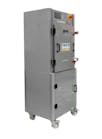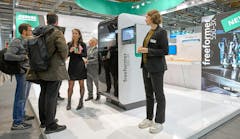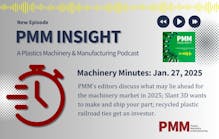3D printing's possibilities inspire entrepreneur, dog owners
By Karen Hanna
Running, jumping, swimming, eating hot dogs.
This is Tika Hopple’s best life.
But until recently, the 9-year-old former street dog did it on three legs.
With the help of additive manufacturing and her family, Tika, a Jack Russell terrier-border collie mix has learned a new trick — using a Barbie-pink, 3D-printed plastic prosthetic to navigate her daily “sniff-aris,” as her owners call her walks. Along the way, she’s become a standard-bearer for a group of young entrepreneurs who believe additive manufacturing will build the future.
Related: Limbitless builds affordable prosthetic arms with artistry and empathy for 'Bionic Kids'
“She goes so much further. Her endurance is just so much longer … going down trails and off of the trails, into the grass, and exploring and then coming back up a little ridge. … And, when she’s back in the car, she’s recovered by the time we get home, after about 5 minutes,” owner Rachel Hopple said as the dog dug into a treat one day in May. “That’s amazing, truly amazing.”
Tika’s success is one part of a vision for 28-year-old industrial designer Alex Tholl, the CEO and co-founder of DiveDesign, a firm that provides consulting services revolving around additive manufacturing. A subsidiary of that company, 3D Pets, has helped Tika and other tripod pets. The company's work has now been featured in an ad for Apple's iPhone.
Tholl believes companies are missing out on the benefits of 3D printing, simply because they don’t have the expertise to best leverage the technology — that’s where DiveDesign comes in.
“We’re a marketing firm for additive technology companies. We help them design and create really compelling assets to do marketing pieces around, whether it’s for the materials or for the technology itself, and the other half of our business actually consults with manufacturers who are struggling with supply chain issues to implement additive technology to ease some of those woes that they have,” he said.
Unleashing the possibilities
From a goat born with a hole in its skull, to companies struggling to source parts, to 3D printer makers wanting to spread their message, Tholl and his team have helped them all. The breadth and scope of their services bear witness to what Tholl sees as the growing versatility of 3D printers.
The technologies’ future holds significant promise, he believes.
“I’d be foolish to say it’s not truly bright, considering how many new materials are entering the market every day and how many new technologies that [process] materials enter the market every day,” he said. “... Ten years ago, we were using machines that were $30,000 that took 30 days to print a part. Obviously, there’s a little exaggeration there, but now we’ve got desktop machines that are printing large parts in 12 hours.”
Working directly with 3D printer makers, as well as users, has given DiveDesign a unique perspective on the opportunities for additive manufacturing.
With experience and a bit of research, users can identify the printer that might meet their needs — and it is not always the most expensive model.
As an example of the company’s work, he described clients that have turned to printers to make parts caught in global supply chain snags, or that have found technologies that can help compensate for labor deficiencies. In one case, a client was experiencing problems receiving from overseas the casts it needed to make metal valves measuring about 3 feet long by 1 foot to 1.5 feet wide.
“The question was, ‘How can we implement additive and potentially solve this?’ And the funny part was our client was very adamant. He said, ‘There’s no way you can do this, there’s no way. You can’t replace metal with plastic; it’s not going to happen,’ ” Tholl said. “So, we came in, we did consulting with him, and turns out that you can, and you can do it for far, far cheaper than you were ever making your parts overseas.”
Often, Tholl said, clients already have invested in additive manufacturing equipment worth hundreds of thousands of dollars, only to be disappointed. For them, DiveDesign’s expertise and experience are eye-opening.
“Working with large companies doesn’t always solve your problems. It’s working with the nimble, small guys that that can really bootstrap and figure out creative ways to solve problems.”
Pet project finds traction
In 2020, as the pandemic took hold, Tholl met an animal orthotist who was trying to make full-limb prosthetics for his patients. It wasn’t going well.
“The problem was building one of them was a financial loss every time, a ton of material waste, a ton of time, and a lot of special people needed to do it,” Tholl explained.
Working with animal-health specialists, Tholl’s team analyzed the process. By implementing 3D scanners and printers, they cut costs, waste and the need for specialized labor.
“We figured out what material is going to work, what machines were going to work, how it’s going to come together, what the business model was going to look like, the ROI, all of that, and it clicked,” Tholl said. “It made total sense.”
That work led to 3D Pets’ creation.
Over the last couple of years, the team has provided prosthetics to dogs, ducks, tortoises, a llama and even the goat, which needed a helmet to protect its head from its rambunctious farm pals.
The team uses scanning apps compatible with Apple iPhone 12 and newer models, as well as traditional rotary tools for post-processing. But it is not picky about the printers it uses.
“A lot of these companies reach out and say, ‘We want you to try our material or our product,’ ” Tholl said. “We have to remain unbiased for our clients that want to implement this. What we have found that works really well for these [prosthetic] devices are very basic, large-format FDM [fused deposition modeling] machines.”
“It’s just a constant optimization,” Tholl said.
A dog’s life
By April 2020, the possibilities of using 3D technologies to create prosthetics were on display for the world to see — on “Wizard of Paws,” a BYU TV reality show about animals adapting to life with new legs.
The show’s spotlight drew the attention of Rachel and her husband, Tim, who became sold on the idea of a prosthetic for Tika. When Tika first came to their home in Tiffin, Ohio, about eight years earlier, the plan was to give her time to recover from medical interventions meant to salvage a long-broken left front knee — a relic of her life as a stray.
But surgery didn’t work, and neither did the plan to just serve as foster parents.
“We then had fallen in love with her. We were taking care of her, fostering her during her surgery, and we couldn’t let her go,” Rachel said.
Having apparently walked for a long time on a broken leg, Tika adjusted well to amputation; even stairs presented little challenge.
While Tika has shown no signs of slowing down, the Hopples wanted to be sure their little dog could enjoy her senior years.
“We just decided then years later … to look into a prosthetic just to keep that front leg as strong as we could,” Rachel said.
To begin the process, the Hopples requested a kit with materials to tailor a prosthetic to Tika; it included special tape similar to an ACE bandage for creating a cast and a cutting tool for slicing the tape.
“We took her out to a shelter at a local park, and we sat her down in the middle of the shelter. We had a bucket of water. You’re supposed to dip the roll in a bucket of water and then start wrapping around her torso. We did that for three rolls, and then we had to keep her pretty stationary for 5 minutes while it dried,” Tim said.
The Hopples sent the cast back to Tholl’s company; within about four weeks, they had received a new prosthetic for Tika.
According to Tholl, not all dogs or their owners are appropriate for prosthetics.
“We’re trying to actually scare people away from buying these because it’s a big commitment, and it’s a lot of money. And if you’re not willing to put in the time to see the results, we don’t want you to waste the money, and we don’t want your dog to potentially have [bad] results,” Tholl said.
Dogs like Tika that are still very mobile are good candidates. Also, like Tika, pets should be trainable and eager to learn, with owners that have enough time to teach.
For Tika, who shares the Hopple home with three other dogs and two cats, a better mix of owners might be hard to find. Rachel is a retired teacher for special-needs children, while Tim used to work in quality control.
Both have skills that came in handy for helping Tika adjust.
Spending about $1,900 on a dog they have come to love was an easy choice.
“We thought even if we’re just throwing money to the wind, we have to try,” Rachel said.
Learning to adapt to the prosthetic took some time.
Tika was not comfortable with the wedge-shaped base that originally accompanied the prosthetic, moving with it only when enticed by hot dogs.
In follow-up video meetings with Tholl, the Hopples advocated for a better approach for their 30-pound pooch — a wheel that Tim has since modified. Like an ice skater balancing between the outside and inside parts of the blade, Tim and Tika have had to discover together which parts of the prosthetic take the impact with each stride.
Since then, they have also added a racket-shaped ski to the mix, for winter rambles.
“She just skims along in front of us and is just truly loving being on four legs,” Rachel said.
Tholl, who has no pets of his own, said he enjoys seeing how both his animal and human clients are taking off with 3D printing.
“A lot of people have been tainted by the companies that said, ‘Our machine can solve all your problems.’ I firmly believe there is some solution out there for a lot of people; it’s just a matter of finding the right one,” said the additive manufacturing enthusiast.
For Tika, who was no fan of the original prosthetic paw, life on three legs and a wheel is rolling along well — she has even paid visits to schools, where young kids have no problem accepting a dog with differences.
To maintain joint health, she takes supplements and undergoes monthly acupuncture treatments.
“She runs and she can do wheelies with her prosthetic on. … She’s pretty much done it all,” Rachel said.
Karen Hanna, senior staff reporter
Contact:
3DPets, 3dpetsprosthetics.com, [email protected]
DiveDesign, Boonton, N.J.,973-348-9402, www.divedesignco.com, [email protected]
Karen Hanna | Senior Staff Reporter
Senior Staff Reporter Karen Hanna covers injection molding, molds and tooling, processors, workforce and other topics, and writes features including In Other Words and Problem Solved for Plastics Machinery & Manufacturing, Plastics Recycling and The Journal of Blow Molding. She has more than 15 years of experience in daily and magazine journalism.










